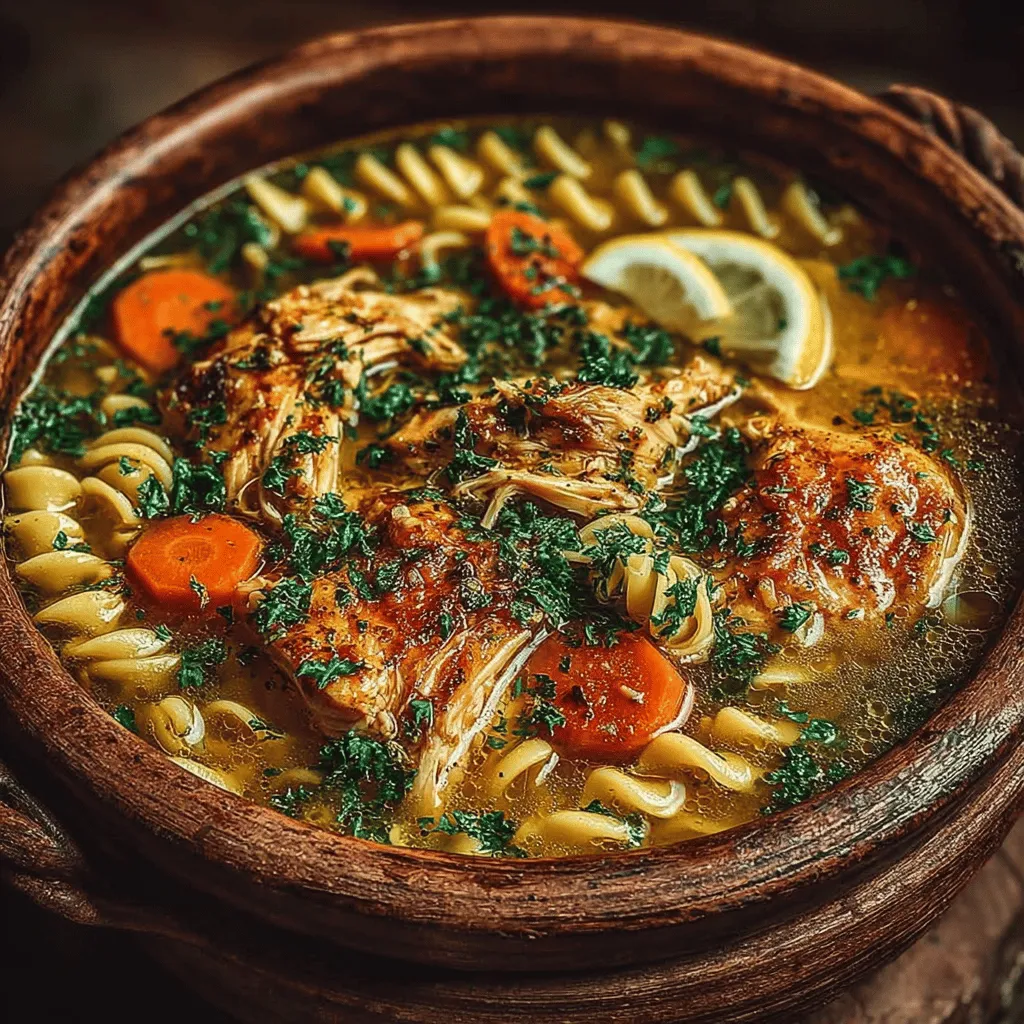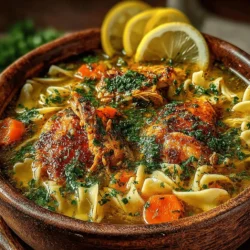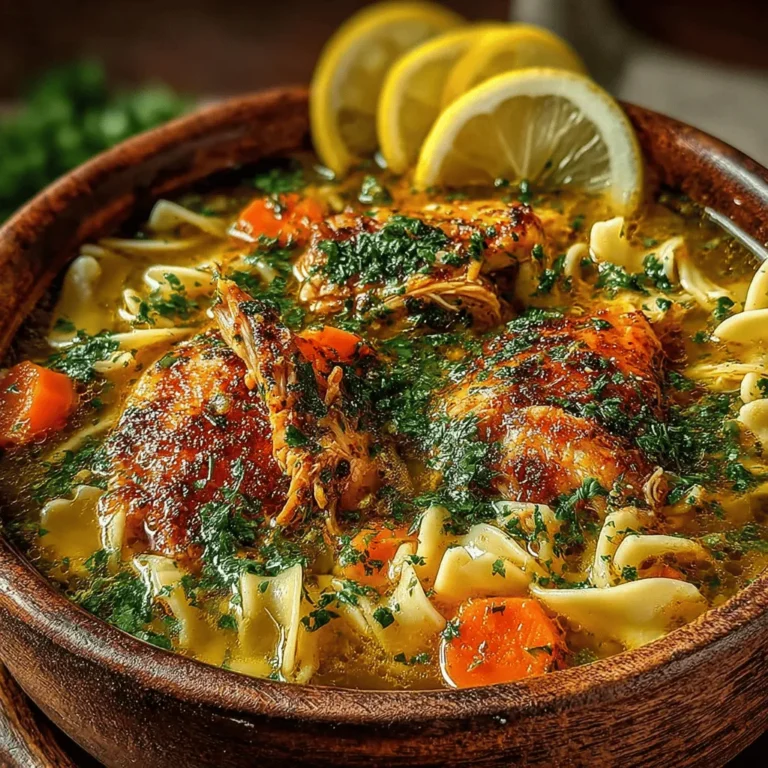Introduction: The Comfort of Classic Chicken Noodle Soup
In every culture, there exists a dish that soothes the soul and warms the heart, and for many, that is a bowl of classic chicken noodle soup. This cozy recipe, with its rich broth and tender noodles, serves not just as a meal but as a comforting embrace on a chilly day or when feeling under the weather. In this article, we will delve into the intricate details of crafting a delicious chicken noodle soup that is not only easy to prepare but also packed with flavors and nutrients, making it a perfect choice for family dinners or solo indulgence.
Ingredients
– 2 tablespoons olive oil
– 1 medium onion, diced
– 3 cloves garlic, minced
– 2 large carrots, sliced
– 2 stalks celery, sliced
– 8 cups low-sodium chicken broth
– 2 cups rotisserie chicken, shredded
– 1 teaspoon dried thyme
– 1 teaspoon dried oregano
– 1 bay leaf
– 4 cups egg noodles
– 1/4 cup fresh parsley, chopped
– Optional: 1 lemon, juiced for added zest
Instructions
1. In a large pot, heat the olive oil over medium heat.
2. Add the diced onion and minced garlic. Sauté until the onion is translucent, about 5 minutes.
3. Stir in the sliced carrots and celery, cooking for an additional 3-4 minutes until the vegetables start to soften.
4. Pour in the chicken broth, ensuring it covers the vegetables.
5. Add the shredded rotisserie chicken, dried thyme, dried oregano, and bay leaf to the pot. Stir to combine.
6. Bring the mixture to a gentle boil, then reduce the heat and let it simmer for 10-15 minutes.
7. Add the egg noodles to the pot and cook according to package instructions, usually about 6-8 minutes or until tender.
8. Once the noodles are cooked, remove the bay leaf and stir in the fresh parsley. If desired, add lemon juice for an extra layer of flavor.
Understanding the Ingredients: The Foundation of Flavor
Exploring the Core Ingredients
– Olive Oil: The base of flavor that enhances every element of the soup.
– Aromatics: Onions and garlic provide a fragrant foundation, critical for depth of flavor.
– Vegetables: Carrots and celery contribute sweetness and a satisfying crunch, balancing the dish.
– Chicken Broth: Opting for low-sodium broth ensures a health-conscious choice without compromising flavor.
– Rotisserie Chicken: This pre-cooked option offers convenience and rich taste, streamlining the preparation process.
– Herbs and Seasonings: Thyme, oregano, and bay leaf add complexity, creating a warm, inviting aroma.
– Egg Noodles: Their unique texture makes them the ideal companion for the broth, absorbing flavors beautifully.
– Fresh Parsley: A simple garnish that brightens the dish, enhancing both appearance and taste.
– Optional Lemon: A splash of lemon juice can elevate the soup, providing a refreshing zest that complements the richness.
Step-by-Step Preparation: Crafting Your Cozy Soup
Heating the Olive Oil: The Importance of Temperature
– Achieving the perfect sauté for onions is essential; the right heat will draw out their sweetness and enhance the overall flavor profile.
– Building the aromatic base with onions and garlic is a crucial first step, as it sets the stage for all subsequent flavors.
Adding Vegetables: The Color and Crunch
– Sautéing carrots and celery not only adds color but also deepens the flavor of the broth, making each spoonful more satisfying.
– Timing and technique are vital when cooking vegetables; they should be tender yet still maintain a slight crunch to provide texture.
Pouring in the Broth: Bringing It All Together
– The significance of using quality chicken broth cannot be overstated; it forms the backbone of the soup’s flavor.
– Combining ingredients effectively ensures a harmonious blend, allowing the flavors to meld beautifully as they simmer together.
Seasoning the Soup: Balancing Flavors
– Proper seasoning is critical; adjusting the herbs and spices throughout the cooking process will help achieve a balanced and inviting flavor profile.

The Art of Seasoning with Salt and Pepper
Proper seasoning is crucial for enhancing the flavors of your chicken noodle soup. Start by adding salt and pepper gradually during the cooking process. This allows you to taste and adjust the seasoning to your preference. Remember that the broth will concentrate as it simmers, so it’s best to err on the side of caution and add salt in increments.
Understanding the Simmering Process
Simmering is key to developing the flavors in your soup. Keep the heat low enough to maintain a gentle simmer; this will coax the flavors from the chicken and vegetables without boiling them to mush. A slow simmer allows the ingredients to meld together beautifully, resulting in a rich, savory broth.
Cooking the Noodles: The Key to Texture
Timing the Addition of Egg Noodles for Al Dente Perfection
To achieve the perfect texture for your egg noodles, add them to the soup about 10 minutes before you expect to serve it. This timing allows them to cook just enough to remain tender while still holding their shape. If you prefer a firmer noodle, you may want to adjust the cooking time accordingly.
Monitoring the Cooking Process for the Right Consistency
Keep an eye on your noodles as they cook. If they’re left in the soup for too long, they can become overly soft and mushy. For the best results, taste them a minute or two before the recommended cooking time to ensure they reach your desired level of doneness.
Finishing Touches: Elevating Your Dish
The Importance of Removing the Bay Leaf
Before serving, don’t forget to remove the bay leaf from your soup. While it adds depth to the flavor during cooking, it is not meant to be eaten. Removing it also ensures that your guests enjoy the smooth texture of the soup without any unexpected bites.
Adjusting Flavors and the Optional Squeeze of Lemon
Just before serving, taste your soup one last time. A squeeze of fresh lemon juice can brighten the flavors and add a refreshing zing. Adjust the seasoning with additional salt and pepper if needed, ensuring a well-balanced flavor profile.
Serving Suggestions: Making It a Meal
Presentation Matters: Ladling and Garnishing
Serving your chicken noodle soup attractively can elevate the meal experience. Use a ladle to serve generous portions in bowls, and consider garnishing with freshly chopped parsley for a pop of color. This not only enhances visual appeal but also adds a fresh herbal note to each serving.
The Impact of Fresh Parsley and Lemon Wedges
A sprinkle of fresh parsley on top of your soup not only makes it visually inviting but also contributes a fresh flavor that complements the dish. Adding lemon wedges on the side allows each guest to customize their soup according to their taste preferences.
Pairing Ideas: Complementary Sides
For a complete meal, consider pairing your chicken noodle soup with crusty bread, a simple side salad, or a cheese toast. These accompaniments enhance the overall dining experience and provide additional textures and flavors that complement the soup.
Nutritional Benefits: Why Chicken Noodle Soup is Good for You
A Nutrient-Rich Profile
Chicken noodle soup is a powerhouse of nutrition, featuring lean protein from chicken and a variety of vitamins from the vegetables. Carrots, celery, and onions not only add flavor but also provide essential nutrients that support overall health.
The Role of Broth in Hydration and Nourishment
The broth in chicken noodle soup is hydrating and nourishing, making it an ideal choice when you’re feeling under the weather. It helps to keep you hydrated while delivering essential nutrients that promote recovery and wellness.
Comfort Food with a Purpose
How Chicken Noodle Soup Can Aid in Recovery
Homemade chicken noodle soup is often touted as a remedy for colds and flu. Its warm, soothing qualities can help alleviate symptoms and provide comfort during illness, making it a go-to dish for nurturing loved ones back to health.
The Psychological Benefits of Warm, Homemade Meals
Beyond physical nourishment, chicken noodle soup brings psychological comfort. The act of preparing and sharing a warm meal can evoke feelings of care, love, and connection, which are essential for emotional well-being.
Conclusion: Embracing the Comfort of Homemade Chicken Noodle Soup
Crafting your own chicken noodle soup is not merely a cooking endeavor; it is a heartfelt experience that taps into tradition and comfort. The layers of flavor, the warm broth, and the hearty ingredients create a dish that is both satisfying and nurturing. Whether enjoyed alone on a chilly day or shared with family and friends, this classic recipe embodies the essence of comfort food, inviting you to relish in its warmth and goodness.


